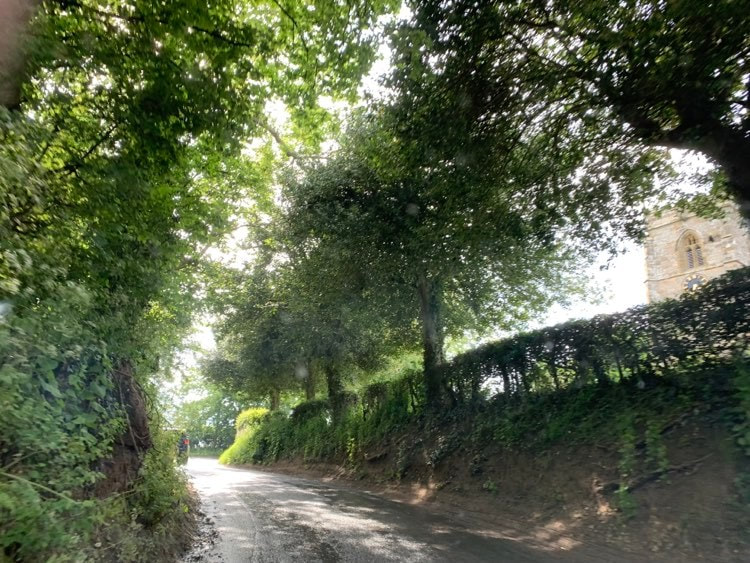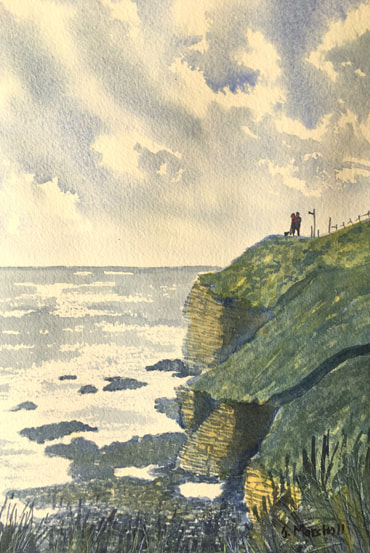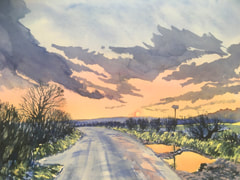|
I have always loved the work of the Victorian Artists. I know they are derided these days as old fashioned and too 'chocolate box'. Well everybody loves chocolate so why not 'chocolate box' paintings? Whatever critics may say about them, they certainly knew their craft. I wanted to try and recreate the 'look' of an old painting in composition, colour and very importantly - title. It is an unashamedly nostalgic scene and I had great fun with it. The main ingredients are big sky, sunset, cluster of buildings, trees and a flowing stream - what's not to like! I used an old fashioned technique too. The arty name is 'glazing', but it just means putting on layers of paint over each other. It does help to get density and variation of colour into the scene. If you want to give it a go, here's a few useful tips (I hope!). Most importantly - ensure the painting is completely dry before you put on the next glaze. It's also a good idea to try and stick to transparent colours. I started with yellow, then blue, and finally several layers of red. Altogether I did about five glazes before I got the effect I wanted, so another tip is to ensure you use a decent quality paper. The sky was painted with my usual one wash and clouds added wet on wet. All this talk about chocolate has made me hungry, so off for a strawberry cream. See you later.
0 Comments
This is the view opposite from where we park to take our two Jacks for a walk in Sledmere Woods. I painted it earlier in the year when one of the fields was red with poppies. I revisited it with different colours and a looser style. Here is the earlier version for comparison: Turkey Lane is a shortcut home after a walk in the beach with the dogs. I have travelled it many times and have often been struck by the contrast of light and shadows when the sun is in the right place. I had a clear vision of what I wanted to achieve with the painting. It is based on a photo merice took through the car windscreen and a sketch I made shortly after. To paint it I followed my mantra - observe, simplify and exaggerate. Let's have a look at the original photo. Clearly, it is a good photograph and illustrates my point about the light effects at certain times. Now let's apply the mantra. Observation - the whole point of the scene is the dark shadows on the lane. They are coming from the left hand side. Because of our vantage point, we are looking up at the trees on the right which makes good shapes. The dark right hand foreground tree makes a nice frame. Next is simplification. This can be the hardest part of the process. I always bear in mind that I already have every single detail of the scene already captured on the photo, so I don't need all of it the painting. The Church can be suggested instead of an accurate representation as my main focus is the shadows. The foliage and plants on the ridge are not essential either so I toned them down too. You can see for yourself other little changes I made to achieve my aim. This leaves 'exaggeration'. For me the emphasis on the painting was always going to be the contrast between light and darks, so I simply strengthened these for dramatic effect. There you have it then in three easy stages.
ASKING THE RIGHT QUESTION
When I first started painting, I would look at someone else’s work and wonder “How did they do that?”. That is a good question and one you have probably asked yourself whilst admiring a piece of art. It is also a useful question to ask especially when you are just starting out on your art journey. I asked it many times and learned from the replies I got which helped me develop my own style of working. The question is though – is it the right question? Jackson Pollack is quoted as saying that he wanted to express his emotions, not illustrate them. Therein lies a clue to a better question to ask an artist, because, if you think about it, the answer to the ‘how’ question is always going to be the same. Does that surprise you? It probably does because you are thinking that every artist will give a different reply to ‘how ‘they did it. However, the answer is always going to boil down to one word – technique. There are a million different techniques of course based on knowledge, experience and skill which will differ from artist to artist. Fundamentally though, no matter how involved or fascinating the answers you get, the answer to the ‘how’ question is always going to be the same, and that is what techniques were used. So, what is a better question to ask the artist? Ask ‘why’ and then you really will get more interesting replies because the individuality of the artist will be expressed in the answer. Let’s try it out. Why did I paint this? Last year, I was looking through some sketchbooks for inspiration. I came across a sketch of Flamborough from the clifftop carpark. It was annotated ‘waiting for Dilly’. Dilly was our last rescue dog before Meg and Peggy. She had had an awful start in life being used as a breeding machine until being abandoned tied on a dual carriageway when she had become too ill to be useful to the puppy farm. Happily, she was rescued and after many weeks of treatment and loving care she eventually came to us. She lived another four and a half years, and we shared much love and joy. It was hard work though. Due to her condition she had to be groomed once a month. The dog groomer lived in Flamborough, so we took her there. It would take about an hour. Often, we would nip into Bridlington and have a cup of coffee, but if I took her on my own, I would go off and do a bit of sketching to pass the time. This had been one such occasion. Seeing it brought back many happy memories and a little sadness, so I was moved to paint it. As a tribute to her memory, I put her with Merice and I on the cliff top which was a walk we had all enjoyed together many times. It is a painting of love. I could have told you the techniques I used but hope you have found this more interesting. So, next time you see a painting you like give it a go and ask yourself ‘why’ instead of ‘how’. Thanks for reading. If you do not already know it, I would like to introduce you to Woldgate. Woldgate runs from Bridlington through to our lovely village, Kilham. It is on the site of an old Roman road that used to go further all the way to Eboracum (York to you and me). There are not many centurions marching along it now! It is on a brow so in between the wooded areas, there are lovely vistas of the Yorkshire Wolds.
I have painted it many times and, not surprisingly, so have many other artists including David Hockney, who spent several years in the area as captivated as everyone else by the beauty of the Wolds. His work formed his unique one-man exhibition in the Royal Academy. It was called ‘The Bigger Picture’ and we were fortunate to be invited to the family and friends preview of the show before the official opening. I noticed these lovely shadows on a recent ‘daily exercise’ walk. Early spring is a great time. The leaves are beginning to appear on the trees and the thickets and hedgerows are already bursting with verdant new life a joy to paint. This is another step back in time to 14th September 2004. Back then, I was spending a lot of time with Tony Hogan at his Arts Centre in Rudston. It was also the time when I was starting to earn money from my art. I was selling paintings regularly. Tony had taken me under his wing and was paying me to help with his students. I would drive over from York to meetup at the Bosville Arms. Whatever time I arrived, Eileen, Tony’s wife, insisted I sit down to enjoy one of her full English breakfasts. Then we’d be off for the day painting. It was an exciting and joyful time…and I was learning new things every day. Eileen provided lunch as well, so we could stay out all day.
It was fun working with other painters. The students were an eclectic mix with different ideas and abilities. It fascinated me (still does!) how different people interpreted the same scene in so many ways. Fordon Road is a good spot to paint. It isn’t too far from base but was right in the middle of the lovely Yorkshire Wolds. It runs from Burton Fleming through to Fordon. Burton Fleming is a thriving village with a splendid pond and several amenities including a well-supported community pub. On the other hand, you might barely notice if you passed through Fordon. It’s a small hamlet rather than a village. This green lane is about halfway between the two. I did a large sketch spread over two sides of an A4 sketchbook – no idea why because the second page was an extension of the fence and the tree covered Wold. I did make a start on the painting but never got anywhere with it. For this one I concentrated on the left-hand page which features the green lane and is much more interesting. I have enjoyed painting it very much and hope I have captured the exuberance of those happy times. "Forest Study 1" Although this is a special painting for me, it has never been posted before. I must have painted it in early 2003 and like most good things that have happened in my life, it was instigated by Merice albeit inadvertently. We lived in a small village just outside York at the time and Merice had been down to the City to do some shopping. As my greatest encouragement she was always on the lookout for things that would help me as a budding painter. She noticed a book in Waterstones that she liked. It was written by an artist called Nita Engle and was very attractively bound with one of her exciting watercolour paintings. Reading it not only inspired me but transformed my whole attitude to painting. I had already discovered that you don’t improve at a gradual rate. You improve with sudden leaps forward and then level out again, maybe even dropping a notch or too before the next step up. Nita’s book was a revelation. It introduced me to the concept of total freedom and joy in expressing yourself. Suddenly I was painting in huge washes letting colours freely flow together. Her central theme was to let the watercolour do the work for you and then add a few details to create a sense of realism. The biggest lesson I learned is that you can’t use too much water in a watercolour painting, and this has become my mantra. Early experiments with this technique were, of course, total disasters and Merice must have wondered what I was playing at. Then one day this painting ‘happened’. Our dining room had become my studio, so I rushed into the lounge and called Merice – “Do you want to see something amazing?” She did and agreed that I had produced something special. This was a giant leap forward and I have integrated these ideas into my work ever since. I could hardly wait to see it framed. My mum also lived in the village, so I took it round to show her too. She loved it and wanted to keep it. She always had to pay me something for the paintings and I let her have it for a nominal sum. It hung on her wall for the next fifteen years and I saw it every time I visited. When mum passed away, I got it back and was finally able to take a photograph so I can show it to you. I have painted many similar scenes and used the same methods in many different subjects, but this painting really is so very special to me as it was the first. Mum got it so quickly that I never had the chance to even give it a proper name. ‘Forest Study 1’ hardly does it justice, so perhaps you can help me out? If you have any ideas for a suitable title, please let me know. I am travelling back in time for this one – back to the 18th August 2004 to be precise. Merice and I were in the Yorkshire Dales. Back then we lived in a village just outside York and we had easy access to the delights of the Dales. We would certainly have taken the shortest route there via Harrogate and Skipton, but on the way home we used to take the scenic route – over the tops to Pateley Bridge, Ripon, Boroughbridge and home without travelling on a main road.
It was the height of summer but there is never any guarantee what the weather will be like up there as It is so very changeable. The sketch was made from the roadside, so I suspect we had stopped for a welcome picnic. As we settled it, out came the sketchbook. I drew it in portrait form, so I have painted it in the same format. As can happen so quickly in the Dales, a storm was racing towards us, hence the title of sketch and painting. Hopefully it passed over but my memory is not that good! "Sunset Drive on Woldgate"A couple of weeks ago we were on our way back home after a pleasant stroll on the beach at Bridlington. It turned out to be a spectacular journey. The quickest way to Kilham is to drive straight down Woldgate right into the village. The sun was starting to set as we set off. It is the usual time to get a good sighting of barn owls. And one did indeed oblige, posing happily on a post whilst Merice snapped away on her iPhone. As we got nearer home, the setting sun was providing an awesome end to the day. I drove slowly and Merice took several shots that I was able to reference when I started the painting, but most of what I wanted to portray was already in my head.
Even in these uncertain times Mother Nature is always on hand to provide us with an abundance of beauty – we just have to look! I was having a rummage through some of my art books and came across an old sketch book. On Saturday 3rd June in 2004, I went to Stainforth Foss with my wife Merice. Situated in the Yorkshire Dales, this was the location for a painting I had been commissioned to do, hence our visit.
I know the date because I had recorded it on a series of sketches I made on the day in preparation for the painting. The actual focus of the work was to be the Foss itself, a place where the River Ribble tumbles down a series of cascades, but I made drawings of the surrounding area as well, including this delightful Packhorse Bridge just up from the Foss. Sketches are so important. The time spent doing them implants not just the scene in your mind but also the ‘feel’ and the emotional response to the day. A photograph would have captured the details, but the sketches captured the essence of the area. I had made a few notes which brought back how soggy it was that day. We arrived in the afternoon, but it had been raining all morning. We were glad of our walking boots as we squelched our way to the Foss. We crossed over the bridge on our way. Because of the rain, everything was sparkling and sharp to the eye. The sky was clearing rapidly, and we ended up with a warm end to the day. This week then, I decided to concentrate on the bridge sketch. I used five colours – French ultramarine, Antwerp blue, Payne’s grey, Windsor yellow and brown madder – and painted it in one sitting in a couple of hours (All right- I might have had a break or two for a cuppa!). But if I get asked the usual question – “How long did it take you to paint that?” – then I can truthfully reply – “Fourteen years.” I’m looking forward to having another perusal of that old sketchbook to see what else I might find. |
AuthorProfessional artist now semi retired and enjoying being eccentric! Archives
September 2022
|












 RSS Feed
RSS Feed
